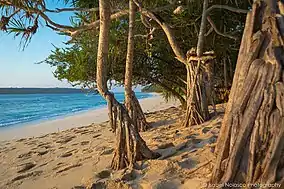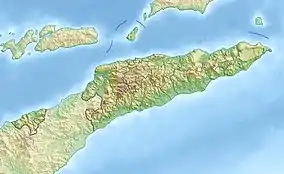| |
|---|---|
 Valu Beach in 2015 with Jaco Island in the background at left | |
 | |
| Location | Tutuala, Lautém, East Timor |
| Nearest city | Lospalos |
| Coordinates | 8°24′44″S 127°18′01″E / 8.4123°S 127.30017°E |
Valu Beach (Fataluku: Valu Sere, Tetum: Tasi-ibun Valu, Portuguese: Praia Valu) is a public beach at the easternmost tip of mainland East Timor, and the gateway to Jaco Island to its east.
Geography
The beach is located in the suco of Tutuala, Lautém municipality, opposite Jaco Island.[1][2]: 207 It is made up of white sand,[1][3] and is partly surrounded by ancient virgin forests.[4] Its waters are translucent, and suitable for swimming, snorkelling, and diving.[1][2]: 229
Local people claim that the beach is "... a place of great spiritual, cultural, historical and ecological significance not just for Tutuala and Lautem district but for all of Timor-Leste."[4] The beach, suco and island all lie within Nino Konis Santana National Park, the first national park in East Timor.[5]
The beach, the island and the 600 m-wide (660 yd) channel or strait between them (known as Jaco Strait) are sometimes said to be where Timor meets the boundary between the Banda Sea (including Wetar Strait) to the north and Timor Sea to the south.[6][7] However, according to the standard work Limits of Oceans and Seas, 3rd edition (1953), published by the International Hydrographic Organization (IHO), the only point where Timor meets those two seas is Tanjong Sewirawa (now known as Cape Cutcha), the eastern extremity of the Timorese mainland.[8][9] Cape Cutcha is a short distance north of the beach, and northwest of Jaco Island.[9]
At the beach and other adjacent beaches, green sea turtles come ashore to lay their eggs. Before the national park was established, some local families would camp at the beaches and keep watch to collect eggs and capture nesting turtles. However, such activities are now prohibited in the national park.[2]: 208
The open area at the back of the beach houses traces of pottery, stone artefacts and shell, along with broken and abandoned contemporary artefacts. Local people say that in the past, local families would exchange pottery, goats and other goods with people from other islands at certain times of the year.[2]: 224 [10]
About a 30 minute walk from the beach is Lene Hara cave, the main element of a system of solutional caves in the Lautém municipality. Further afield, about a two hour trek from the beach, is Ile Kére Kére, a limestone overhang. Both sites are decorated with rock art.[2]: 229 [4][11]
Facilities
A road links Tutuala with the beach. The road was previously somewhat treacherous, and therefore helped to protect the island from overtourism, but has since been improved.[12]
The beach is the gateway to Jaco Island, and a fishing co-operative operates boats to carry passengers between the two places. The currents in Jaco Strait are too strong for people to make the journey by swimming across it.[4][13]
Close to the beach is a community-run eco-resort/guesthouse in shaded grounds, with open-air bungalows. It was opened in 2005, shortly before the national park was created. The facility's buildings are made of local materials such as such as bamboo, grass, palm leaves, and wood. A central hut is used for serving simple local meals (including rice, maize, cassava, sweet batata, and taro, along with local varieties of beans and vegetables), and usually basic supplies are available. There is also a beach campsite[2]: 207 [4][14]
Members of the fishing co-operative catch and cook fish for visiting tourists.[2]: 207 [4] They set up temporary shelters for themselves, and keep their boats at the back of the beach, where racks and limestone caverns have been created for the storage of their possessions.[2]: 207–208
Culture
The major cultural event in the national park is the Mechi ceremony, which is held on the beach and on Jaco Island. The ceremony involves the ritual gathering of and feasting on palolo seaworms (Eunice viridis), which are known as mechi in the local Fataluku language. Two Mechi ceremonies are held each year: in the last quarter of the moon in February, at which time there is a minor Mechi kiik harvest, and at the new moon in March, when the major Mechi boot harvest takes place.[5][15][16]
On both occasions, local communities gather at night to conduct the ceremony, as the mechi are photosensitive. The harvested mechi are combined raw with chili and lime to create a marinated salad. The gathering, feasting and associated ritual invocations, singing and dancing mark the beginning of a new agricultural calendar, and are also important in creating, strengthening and renewing bonds and alliances between the participants in the ceremonies.[16]
See also
References
- 1 2 3 S, Peter (26 December 2019). "Top 10 Things To Do In Timor Leste". WOW Travel. Retrieved 5 July 2022.
- 1 2 3 4 5 6 7 8 O'Connor, Sue; Pannell, Sandra; Brockwell, Sally (2013). "14: The dynamics of culture and nature in a 'protected' Fataluku landscape". In Brockwell, Sally; O'Connor, Sue; Byrne, Denis (eds.). Transcending the Culture–Nature Divide in Cultural Heritage: Views from the Asia-Pacific region. Acton, ACT: Australian National University Press. pp. 203–233. doi:10.22459/TA36.12.2013. ISBN 9781922144058.
- ↑ Bhatia, Aunindita (29 May 2022). "10 Facts About The Lesser-Known Timor-Leste". TheTravel. Retrieved 5 July 2022.
- 1 2 3 4 5 6 Welcome to Valu-Sere and Jaco Island (PDF), Tutuala: Valu Sere Co-operative (brochure), 2012, archived from the original (PDF) on 14 December 2012, retrieved 8 July 2022
- 1 2 Nino Konis Santana National Park: The First National Park in Timor-Leste! (brochure) (PDF), Dili: Ministry of Agriculture and Fisheries (East Timor), archived from the original (PDF) on 3 November 2013, retrieved 5 July 2022
- ↑ "East Timor Travel: Why Go to a Country So Few People Ever Visit?". Women on the Road. 19 March 2019. Retrieved 9 July 2022.
- ↑ Sailing Directions for Java: Lesser Sundas; South, Southeast, and East Coasts of Borneo; and Celebes. Publication - Defense Mapping Agency, Hydrographic Center, no. 72 (revised 5th (1962) ed.). Washington, DC: U.S. Dept. of Defense, Defense Mapping Agency, Hydrographic Center. 1976. p. 272. ISBN 1038099951.
- ↑ Limits of Oceans and Seas (PDF). Special Publication No 28 (3rd ed.). Monte-Carlo: International Hydrographic Organization (IHO). 1953. Archived from the original (PDF) on 8 October 2011. Retrieved 28 December 2020.
- 1 2 Timor-Leste (PDF) (Map). Cartography by Department of Peacekeeping Operations, Cartographic Section. United Nations (UN). January 2004. Map No. 4111 Rev. 8. Retrieved 16 July 2022.
- ↑ Miksic, John N.; Goh, Geok Yian; O'Connor, Sue (2011). Rethinking Cultural Resource Management in Southeast Asia: Preservation, Development, and Neglect. Anthem Southeast Asian studies series. London: Anthem Press. pp. 57–58. ISBN 9780857283894.
- ↑ "Rock Art Caves | Timor-Leste Attractions". Lonely Planet. Retrieved 8 July 2022.
- ↑ "The Best East Timor Beaches: One Dollar Beach". Manny Timor Adventures. Retrieved 8 July 2022.
- ↑ Das, Shubhanjana (19 April 2019). "Jaco Island In Timor Leste: Discover This Mythical Beauty!". Travel + Leisure India. Retrieved 9 July 2022.
- ↑ "Valu Sere | Timor-Leste Hotels". Lonely Planet. Retrieved 5 July 2022.
- ↑ Edyvane, K; McWilliam, A; Quintas, J; Turner, A; Penny, S; Teixeira, I; Pereira, C; Tibirica, Y; Birtles, A (October 2009). Coastal and Marine Ecotourism Values, Issues and Opportunities on the North Coast of Timor Leste – Final Report (PDF) (Report). The Timor-Leste Coastal/Marine Habitat Mapping for Tourism and Fisheries Development Project: Project No 2. Ministry of Agriculture & Fisheries, National Directorate of Tourism, Government of Timor-Leste. p. 48. Archived from the original (PDF) on 29 March 2013. Retrieved 8 July 2022.
- 1 2 Edyvane, K; de Carvalho, N; Penny, S; Fernandes, A; de Cunha, CB; Amaral, AL; Mendes, M; Pinto, P (October 2009). Conservation Values, Issues and Planning in the Nino Konis Santana National Park – Final Report (PDF) (Report). The Timor-Leste Coastal/Marine Habitat Mapping for Tourism and Fisheries Development Project: Project No 4. Ministry of Agriculture & Fisheries, National Directorate of Tourism, Government of Timor-Leste. p. 55. Archived from the original (PDF) on 29 March 2013. Retrieved 8 July 2022.
External links
![]() Media related to Valu Beach at Wikimedia Commons
Media related to Valu Beach at Wikimedia Commons